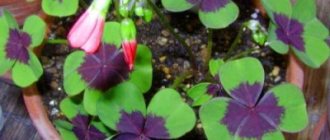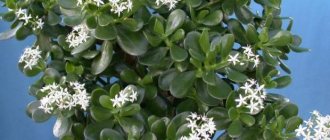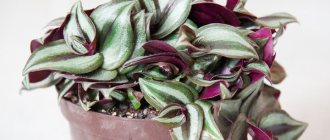Solving possible problems during cultivation
The plant needs warmth, regular watering and timely feeding. If a ficus is not properly cared for, its foliage may turn yellow, and if not properly cared for, it will become ill and die.
Care errors
If the leaves fall off, it means the air is too dry and the plant lacks nutrients and moisture. If the edges of the leaf blades turn yellow, after which the tree sheds its leaves, it means the plant is suffering from waterlogging. Such problems will not arise if watering is organized correctly.
Pests
Ficus Natasha can be affected by insects. When pests are found, they are collected manually or sprayed with insecticides.
Shchitovka
These are small brownish insects with a shield on their back. Scale insects settle on the plant in colonies and feed on its sap. They are removed manually with a swab soaked in soapy water. Insecticides (Actellik) are used to control insects.
Spider mite
A tiny red insect that weaves a web on leaves and stems. It feeds on the sap of the plant; its vital activity is indicated by yellow spots on the leaves. You can get rid of ticks by spraying with a solution containing an acaricide (Kleschevit, Fitoverm).
Thrips
Oblong brown insects that live in the soil mixture and cause damage to the roots of the plant. Insecticides (Aktara, Fitoverm) save you from thrips. If pests are detected, it is advisable to replant the plant in fresh soil. Before transplanting, the new soil mixture must be disinfected or calcined in the oven (stove).
Mealybug
A tiny, hairy, white insect that settles on the plant in colonies. It feeds on the juice of leaves. Pests must be collected manually using a damp cotton swab. To combat insects, insecticides are used (Aktara, Aktellik).

Nematodes
These are tiny worms that cannot be seen with the naked eye. They settle inside the roots, stems or leaves of the plant and feed on its juices. Nematicides (Karbofos, Phosfamide, Chloropicrin) save from nematodes.
Aphid
Tiny greenish or yellowish insects that settle on the plant in colonies. They feed on the juice of leaves. If insects are found, you need to take a swab soaked in a soapy solution and wipe the areas where the aphids are located. Spraying with insecticides (Biotlin, Tanrek) saves from the pest.
Diseases
If the plant is flooded with water and rarely fed, it may get sick. If spotted leaves or areas of rot are detected, immediate action must be taken. First of all, all diseased parts of the plant must be removed. It is advisable to transplant the ficus itself into a new, healthy soil mixture; first you need to inspect its roots and remove all rotten places.
Gray rot
A fungal disease that develops at high humidity in weakened plants. Gray mold appears on the leaves. The area located under the plaque becomes brown. The affected leaf must be removed. The plant itself is sprayed with a fungicide solution (Fitosporin).
Anthracnose
This is a fungal disease that causes rust-like spots to appear on the leaves. Subsequently, they fall out and holes form. Anthracnose is treated with copper-containing fungicides.
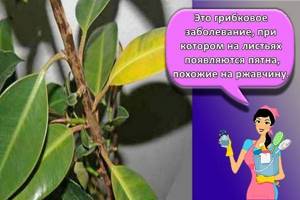
Root rot
With increased soil moisture, a fungus can develop that causes root rot. The affected area darkens, begins to soften and decompose. A diseased plant withers and withers, as if it lacks moisture. In this case, the ficus needs to be transplanted into a new substrate. Before transplanting, it is recommended to inspect the roots, remove rotten ones, and disinfect the wounds with crushed coal.
Sooty mushroom
A fungal disease that appears when soil moisture is high and there is a lack of nutrients. The leaves are covered with a coating similar to black soot. If damage is detected, watering should be reduced and diseased leaves should be removed. Ficus can be sprayed with a fungicide solution (Strobi, Skor).
What is needed to propagate a plant: conditions and tools
It is best to propagate Ficus Benjamin in spring or summer. When autumn comes, the plant should not be touched, especially in winter. Until the onset of spring, it remains in a dormant period, and if it is disturbed by cutting cuttings or leaves, it is very likely that its immunity will weaken and diseases will appear.
Experienced gardeners consider the months from May to August to be the most favorable months for transplanting or propagating ficus at home.
We should not forget about the sterility of the cutting parts of the instrument when working on plants. Before use, the instrument is treated with alcohol, hydrogen peroxide, chlorhexidine or other antiseptic agents.
In addition, if cuttings are taken not from one bush, but from different ones, then the instrument is disinfected after working on each flower. In this way, healthy plants will not get sick.
Cuttings
Procedure:
- Select from the ficus that will be pruned shoots five to fifteen centimeters long, which should have two or three nodes. Shoots are selected that are semi-lignified or completely lignified. Young green shoots are not suitable for cuttings. Cuttings can be taken from both the side branches and the top of the ficus.
- Using pruning shears or a knife, make an incision at an angle of 45º under the lower bud. To quickly form future good roots, shallow cuts are made on the cuttings, then treated in a root growth stimulator (Kornevin is considered the most popular).
- Be sure to remove the milky juice released at the cut site. To do this, the cuttings are placed in warm water for one hour.
- The container is filled with a mixture of peat and perlite or sand, moistened and the cuttings are planted.
- The plantings are covered with a glass cup or jar, and try to maintain a stable temperature of about 26 ºС. After three weeks, the cutting will send out roots.
By layering
The most popular way to grow an independent bush. Perform the following actions:
- On the main flower, select a shoot from forty to fifty centimeters long.
- On the shoot, mark the area where the roots will be, and remove two or three leaves from this place.
- Two circular cuts are made in the bark of the targeted area, so that there is a distance of up to three centimeters between them.
- Remove the bark in a ring-shaped manner at the site of the incisions. This created a three-centimeter-long area with cut bark.
- Where the bark is removed, a root growth stimulator – “Kornevin” – is applied.
- Sphagnum moss is fixed to the area treated with Kornevin and must be moistened with a spray bottle.
- The resulting area is covered with plastic film and tied with thread, tape or wire for fixation.
- The moisture content of the moss must be maintained; to do this, add water under the film using a syringe.
- After two months, a powerful root system will form around the moss.
- The cuttings are cut below the level of the formed roots and planted in a new pot.
- The cut site on the main plant must be treated with activated carbon so that the plant does not get sick. It will also begin to grow new lateral decorative shoots.
If these conditions are met, as well as regular moistening of the moss, roots will form well.
Leaves
- An incision is made under the bottom leaf.
- One centimeter is removed from it and an incision is made again.
- The next notch is marked above the second leaf.
- Ultimately, the required number of blanks is obtained, that is, fragments of stems with leaves.
- The cuttings must be soaked in water for one hour and the milky juice is removed.
- A capacious pot is selected to freely accommodate all the cuts. Drainage is placed at the bottom of the pot, the layer of which does not exceed three to four centimeters.
- Fertile, light and loose soil is placed in the pot. The best option is a mixture of peat and fertile soil.
- The resulting blanks are placed in the soil in a pot. The shoots should be positioned so that the leaves bend slightly over the sides.
- To quickly root the workpieces, the pot is covered with plastic wrap or a transparent vessel, but so that the covering material does not touch the cuttings. Periodically, the polyethylene is removed, the small plants are allowed to breathe, the soil is moistened and covered again.
The root system takes two to three months to form. After this, young ficus plants with a newly formed root system are transplanted into pots prepared for them.
Seeds
This method of propagating Ficus Benjamin is less popular among flower growers, since it is the most labor-intensive and time-consuming. But still, this method of planting has undoubted advantages - it is believed that the ficus will grow very viable, strong and will have a special decorative effect.
In apartment conditions, ficus benjamina seeds will not ripen, since there is no pollination indoors.
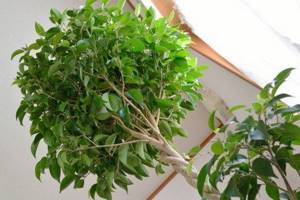
Reproduction methods
Cuttings are the best way to propagate this tree. It is recommended to take a shoot 10-12 cm long during the period of pruning branches, that is, in spring or early summer.
Here's what you need to do:
- cut the stalk;
- put the shoot in water and wait for the juice to dissolve;
- replace water;
- wait for the first roots. They will appear in 2-3 weeks;
- plant a tree in the ground.
Important! When the plant juice dissolves, the water must be replaced. Within 2-3 weeks the first roots will appear. Then you can plant in the ground with a 1:1 ratio of turf soil and sand. Any root activator is added to the ground. It is necessary to act carefully so as not to damage the nascent root system.
Growing problems
This plant is an unpretentious crop, but with frequent mistakes in care, the ficus becomes capricious. Most often, inexperienced gardeners encounter the following problems:
- The leaves of the plant have turned yellow. This is how the plant reacts to a lack of light or moisture. If you often water a flower, but its leaves still turn yellow, then this phenomenon is caused by excessive moisture. Adjust the care of the flower, move it to a brighter place or install a phytolamp nearby, and the ficus will quickly restore its normal color.
- Leaves and stems dry out. As a rule, a lack of watering leads to this phenomenon. But the plant can also dry out due to exposure to a draft. Move the pot to a more protected place and do not forget to regularly water and spray the ficus.
- The tips of the leaves dry out and brown spots form on them. This phenomenon occurs due to too hot conditions. And the tips can also dry out if there is insufficient watering. To return the plant to its decorative appearance, correct the situation depending on the cause.
Providing proper care for ficus at home is not so difficult. The main thing is to adhere to the norms of agricultural technology and create comfortable conditions for the plant. And it will definitely reward you with its rapid growth and chic appearance.
What ficus benjamina looks like, what family does it belong to?
Ficus benjamina from the Mulberry family is a common houseplant. Ficus varieties are distinguished by a variety of colors; the perennial has a positive effect on the air quality in the apartment.
Ficus benjamina will decorate any interior
Ficus is named after the famous botanist Benjamin Deidon, who first described the plant. In its homeland - India, China and the Philippines, ficus grows as a tree with numerous shoots up to 25 m high. It blooms in nature with inconspicuous flowers, the orange fruits are inedible.
Common varieties
Popular varieties that can be grown at home are presented below.
- Starlett is a highly decorative variety with brightly colored foliage. On the green background of the leaf plate, spots and stripes of white and cream color are scattered. The flower is demanding of care. Requires high air humidity, room temperature above +20 °C, and placement in a bright place.
- Kinki is a small bush up to 40 cm high. Decorative with green leaves with a light border. With insufficient lighting, variegation is lost. Trimming gives the plant a beautiful spherical shape.
Ficus benjamina variety Natasha
- Exotic is an unpretentious variety that can grow in partial shade. The leaves are juicy green, densely located on the stem.
- Golden King - bushes are highly decorative. There are green stripes on a light green background of foliage with a yellow border. Over time, the leaves become monochromatic.
- Natasha is a popular small-leaved ficus variety. Young glossy foliage has a light green color that gradually darkens. The bush produces many shoots and tolerates pruning well. Loves daily spraying, does not tolerate drafts and direct sunlight.
Medicinal properties
The flower is a plant that improves indoor air quality and absorbs toxic substances. Ficus benjamina neutralizes fumes of formaldehyde, phenol, and benzene. Its glossy leaves actively enrich the air with oxygen.
Ficus variety Starlight
Medicinal properties of ficus:
- juice extract from the leaves is used for joint diseases: radiculitis, arthrosis, arthritis;
- alternative medicine considers the plant juice useful for uterine tumors;
- The juice of the leaves is used to smear warts and papillomas.
Important! Ficus can cause an allergic reaction in people with latex intolerance. The milky sap of the plant contains rubber
Ideal conditions for keeping ficus
Good conditions for ficus include several aspects of cultivation - diffused lighting, moderate regular watering, warm indoor air (18 - 25°C), timely fertilizing and air humidity of more than 50%.
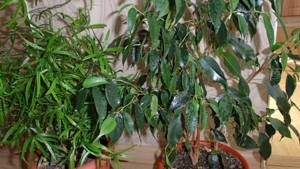
In winter, there are some peculiarities of maintenance depending on the air temperature. However, in any case it should not fall below 16°C. The cooler it is, the less often the ficus is watered. The top layer of soil should dry out between waterings to a depth of about 5 cm.
Read also: Do-it-yourself green gazebo
When choosing a location for a plant, you need to take into account that it does not tolerate drafts. But fresh air is useful in the summer, so when it’s warm, the ficus can be taken out to the balcony, placing it in a corner where it’s not blowing.
Ficus propagation
There are two methods of growing ficus "Natasha" - by seeds and cuttings. The seed method is used less frequently due to the slow growth of seedlings.
- Seeds. Before sowing, the seeds are soaked for a day in a solution of Epin or Heteroauxin. This increases the germination of seeds and the resistance of seedlings to diseases. Seeds are planted in light soil to a depth of about 5 mm. The soil is moistened with a spray bottle and greenhouse conditions are created. Every day the film is removed and the greenhouse is ventilated for 10-15 minutes. The temperature is maintained within 23-25C. Create bright lighting, do not place in the sun. If necessary, organize artificial lighting. At the stage of the first true leaf, picking is carried out.
- By cuttings. It is much easier to propagate Ficus Benjamin "Natasha" by cuttings. The branches remaining after pruning can be used as cuttings. According to the rules, strong shoots with lignified trunks are selected for cutting cuttings. They are cut into pieces. Each should have 2-4 buds with leaves. A larger number of buds are not left - this leads to excessive evaporation of moisture. The cuttings are placed in water, wait until roots appear and are planted in moist soil.
You can root cuttings immediately after cutting. They are washed to remove milky juice and slightly dried. The cuttings are stuck into wet sand at a slight angle. Cover the top with film or a jar. The shelter is removed after new leaves appear.
Advice! Young plants need support to form an even trunk. Bamboo sticks work well as supports. When the trunk becomes stable and stronger, they are removed.
Reproduction
Summer is a good time to propagate Ficus Natalie. The best method of propagation is cuttings.
For cuttings, shoots that are already lignified are selected; green shoots are not suitable, since there is a high probability of non-rooting. One cutting should contain from 2 to 4 leaves with buds.
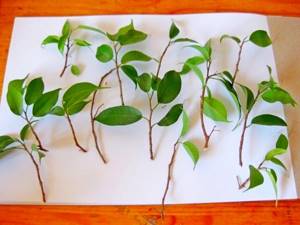
The cuttings are placed in a glass of water and the water is changed daily, as the vegetative parts secrete white juice. After 2 weeks, callus forms on the cut cuttings, then roots appear. At this time, the cuttings can be planted in separate pots.
The cuttings can be planted in the soil immediately after cutting, allowing them to dry for a couple of hours at room temperature until the juice stops flowing.
Read also: How to properly peel a mango with a knife video
Rooting will be faster if the pot with the plant is covered with a jar. After the root system has formed, the jar is removed and the new specimen is cared for as if it were an ordinary ficus.
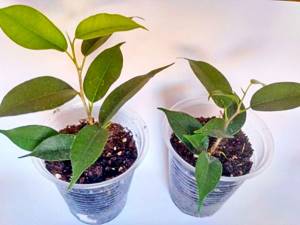
Signs and beliefs about ficus
The shape of ficuses resembles small trees; they delight with their appearance, and are not very demanding in terms of care. It is enough to choose a suitable place for them, water them after the soil has completely dried and spray them more often. These manipulations are accessible even to novice flower growers. When you plant a plant on your windowsill or desktop, you want to know more about it, not only in terms of care, but also about its magical properties and the way it affects humans. Ficus trees actually have similar properties.
Interesting fact. The larger and older the plant, the more powerful the factor of its influence on the surrounding atmosphere and people.
There are quite a lot of signs associated with ficus trees. Some of them work, but others are difficult to test. And, nevertheless, they all recommend that emotional, hot-tempered and, conversely, withdrawn people have a plant. Ficus in the house is a good omen. The more beautiful the plant looks, the better. Having a flower at work means getting rid of unnecessary worries over trifles.
What ficus Daniel looks like
Ficus Benjamin Daniel is difficult to classify as a flowering family, since in the classical sense it is a tree that feels great in a pot. In good conditions it can grow up to 2 m.
Common varieties
In nature, there are up to 1000 species of different ficuses. Almost all of them are attractive with their foliage and spreading crown. Leaf plates are:
- plain;
- with spots;
- small;
- big.
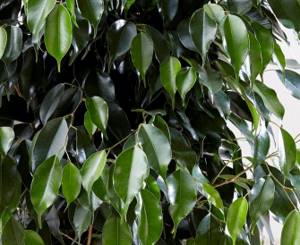
Ficus Daniel greenery that fits into any design
In addition to Daniel, the following domesticated varieties are known:
- Starlight;
- Natasha;
- Kinky;
- Golden King;
- Viandi;
- Exotic;
- Carly;
- Fantasy;
- Monique.
Medicinal properties
Plant growers really appreciate the beneficial qualities of the ficus Daniel; caring for it at home is not difficult. In response to care, he is able to purify the air. Daniel absorbs dust and harmful impurities like a sponge. This is a real green orderly that absorbs benzenes, formaldehydes and ammonia.
It is also believed that ficus can improve the psychological atmosphere in the apartment. The plant improves energy, neutralizes anxiety and anger.
Note! In China, even a photo of a ficus is considered favorable for the home environment.

The greenery of the flower is favorable for the home
Daniel's story begins in ancient times. The tombs in Egypt are made from the wood of this plant. Some ficus trees are considered sacred.
How to form a crown correctly
The plant needs crown formation. This procedure is carried out at the very beginning of ficus growth. Preferably at the end of February. If you plan to grow a bush, its top is trimmed at a height of 15-17 centimeters. After such pruning, the plant begins to form many side shoots. They are also cut at a height of 15 centimeters. If they want to get a standard (a small tree on a thin trunk with a lush crown), then the top is cut off at a height of 35-70 centimeters. The lower part of the trunk is cleared of side shoots.
You can get a tree in another way. For example, from the three lower branches 30 centimeters long, braid a pigtail. All side shoots on them must be removed. Leave only the top branches. The braid itself can be wrapped in burlap for a while. When the stems grow together, the burlap or ropes can be removed.
How to braid ficus Natasha
So that the ficus can later be braided and created a fancy shape, it is necessary to plant several cuttings in one pot. After pinching and trimming the shoots, you can form whatever you want.
From two copies you can create a spiral shape by twisting the trunks into a bundle. If 3 plants are planted, you can braid them. The entire procedure must be carried out carefully, trying not to damage the branches.
As the plant grows, it will get used to the shape and it will be easier for it to develop according to the given pattern. The weave should be loose.
Here's how to do it correctly:
What is Ficus Benjamin?
This plant belongs to the Mulberry family. Many people call this flower a “crying tree” for its unusual structure and shape of the leaves. There are a huge number of species of domestic flowers in the genus, and one of the most common is the Benjamin ficus, which can often be seen in apartments or private houses.
Ficus benjamina is an evergreen tree that in the wild can grow up to 20-25 meters in height. The leaves of the plant are quite beautiful, have a rich green color and a smooth surface.
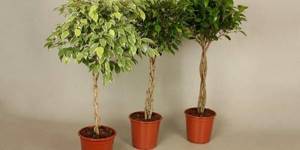
Ficus benjamina grows up to 20-25 meters in the wild
This type of ficus includes a huge number of different varieties. Among them the following can be noted.
- Anastasia.
- Natasha.
- Baroque.
- Daniel.
- Desgentel.
- Exotic.
- Golden King.
- Viandi.
- Starlight.
And this is not a complete list of existing varieties of this type of home tree. Each of the presented ones differs in the shape, color or smoothness of the leaves, as well as growth or root system.
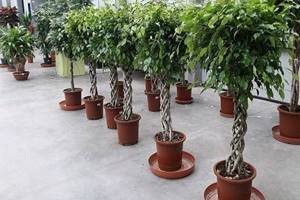
There are different types of ficus benjamina
Caring for ficus at home
Having provided a comfortable microclimate, the indoor flower also needs to be provided with regular care.
Watering rules
Water Natasha only with soft, settled water at room temperature. Since the root system of the plant reaches almost to the very bottom of the flowerpot, irrigation is carried out in two ways:
- moisten at the root with a small stream until the liquid begins to flow into the pan;
- The pot with the ficus is placed in water for a quarter of an hour.
In spring and summer, ficus is irrigated every three days and periodically sprinkled on the leaves. In autumn and winter, watering is reduced to three times a month, and the leaves are wiped with a damp sponge.
Fertilizer application
Tropical exotics are fertilized from early spring to early autumn. Twice a month it is fed with mineral complexes, which alternate with organic matter. Potassium-phosphorus preparations can be applied in any way, but natural fertilizers are better added at the root. In this case, the procedure is carried out 8 hours after watering.
Crown formation
The young plant has a rapid growth rate, and therefore is pruned annually for the first four years. The crown is formed in the spring by shortening the main shoots and removing shoots growing to the side. In summer, sanitary pruning is performed. During the procedure, young shoots up to 50 mm long are cut off.
Taking advantage of the flexibility of the shoots, some gardeners braid the ficus. To do this, several trees are planted in one flowerpot, and after adaptation, the trunks are intertwined, cutting off the side shoots. Then they are fixed with a tourniquet, which is removed no earlier than after 6-9 months.
Features of transplantation
Until the age of five, the pot of tropical exotics is changed annually, then this is done every three years. In this case, the new container is taken 5-10 cm larger than the previous one. The procedure is carried out from the end of winter to the beginning of summer using the transshipment method, preserving the earthen lump. The soil for Natasha is mixed, consisting of turf and leaf soil, sand, peat, and charcoal. The substrate must be heat treated at a temperature of 50 °C. The transplant algorithm consists of several stages:
- the new flowerpot is treated the day before with a weak solution of copper-containing preparations and then dried well;
- Expanded clay is laid on the bottom of the flowerpot, and sand on top of it;
- the flower is carefully removed along with the earthen lump, removing a centimeter layer of earth;
- the perennial is installed so that the root collar is at surface level;
- the free volume is filled with substrate, which is then lightly compacted and moistened.
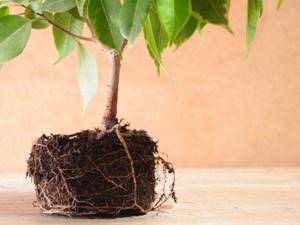
When transplanting, they try to preserve the earthen lump
Watering and fertilizing
It is better to water Natasha in several stages. Thanks to this, it will be possible to achieve uniform distribution of liquid in the ground. Watering should only be done with water that has stood for at least 24 hours. The water temperature should be room temperature.
Water the plant with settled water
Ficus does not tolerate dry soil, but excessive watering will also be harmful for it. Therefore, it is recommended to pour out the remaining water in the pan after watering, otherwise the roots of the flower will rot and it will die.
If at some point in time the ficus leaves begin to turn yellow, the reason may be poor watering or a change in regime. All that needs to be done is to help the tree adapt and establish its watering regime.
Important! As for fertilizing, it is better to carry it out in the spring and summer, since it is at this time that the plant begins to actively grow. You can feed the flower using mineral fertilizers, but you should ensure that the dosage is observed. If you want to achieve a thick flower crown, then you can use nitrogen fertilizers.
It is better to feed the plant during the period of active growth, i.e. in warm seasons
It is worth noting that it is not recommended to use different fertilizers at the same time, since the tree may suffer from fungus as a result.
Is ficus poisonous?
In addition to negative superstitions, the flower has gained unpleasant fame from the statement that it is poisonous. Many people think about this before purchasing a ficus, and therefore it is worth understanding this issue.
Ficus is indeed poisonous, but only for those who are allergic to such plants. The fact is that during the process of growth, the flower secretes a special milk. Its release contributes to the exacerbation of allergic reactions in those who are susceptible to a similar problem.
In this regard, sometimes purchasing a ficus for your home becomes a truly undesirable decision, and it is better to replace the indoor flower with another one to which you are not allergic. Otherwise, the secreted juice can cause not only irritation, but also cough and asthma. Situations also arose when a person developed a fever as a result of an allergic reaction.
Some people may be allergic to ficus
But this does not mean that the plant is dangerous for others. No, the flower will only cause problems for those who are hypersensitive to the substances contained in Natasha’s milk. In all other cases, the plant will not only not be considered poisonous, but will also bring benefits to the house, playing the role of a certain filter.
In the process of growth and development, ficus rids the air of negative substances and produces huge amounts of oxygen. That is why it is recommended to plant the plant in the homes of those who live in large cities that are quite polluted with exhaust gases.
Thus, ficus is a tree that has a rather versatile “reputation”. The choice of which signs to believe in depends only on who decided to acquire this flower. However, it is worth noting that if you believe only in good things and take care of the plant, it will definitely improve the atmosphere in your home.
Difficulties in growing: problems and solutions
Ficus Benjamin variety "Natasha" gets sick infrequently. Difficulties with flowers usually arise from improper care at home. I advise you not to start the process and provide assistance at the first signs of illness.
Often the cause can be found by elimination. To do this, carefully monitor the flower during stressful moments - the first months after purchase, as well as after replanting and feeding.
Leaves turn yellow and fall off
This reaction is typical for ficus Benjamin and may indicate a number of reasons:
- Excess and stagnation of moisture. In addition to yellowness, this is indicated by the lethargy of the leaves. Check the soil, if it is completely wet, do not water the flower for a while. If you have not changed the pot since purchasing, replant it, ensuring good drainage.
- Unbalanced soil mixture. Perhaps there are not enough nutrients in the soil, there is an excess of pesticides, or you have overdone it with fertilizing.
- Hypothermia. Ficus benjamina are sensitive to cold, so buy them when the temperature is above zero. Do not place them on a cold floor, avoid drafts and contact of leaves with cold window glass.
- Lack of light. If your windows don’t get enough sunlight, place a fluorescent lamp next to “Natasha”.
- Lack of moisture. In this case, not only yellowing, but also dryness of the leaves is observed. Ensure timely watering; in hot weather, spray the crown with a spray bottle. Once every 1.5-2 months, take a warm shower, protecting the roots in the pot with plastic film.
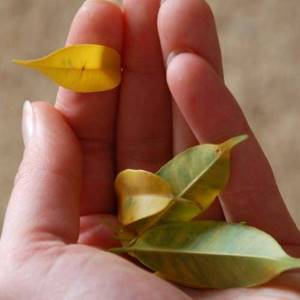
The stem darkened, the leaves fell off
The sign indicates a critical situation with the roots, in which the death of the plant is not far away. This is due to improper planting, poor drainage, and excess water. The flower should be replanted, while carefully inspecting the roots - cut off the rotten ones, treat the rest with a clear solution of potassium permanganate.
The leaves curl inward
The edges of the leaves curl up due to sunburn, freezing of the roots, or lack of nitrogen. In the first two cases, it is enough to move the pot to the most suitable place and wait for the leaves to straighten.
If the flower is already in good conditions, but the leaves still curl, apply nitrogen fertilizer designed specifically for ficus plants.
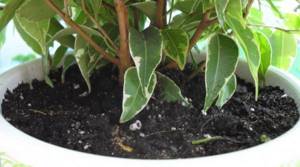
Pests
They can affect the plant if other indoor flowers are sick. When infected with thrips, brown spots appear and shoots become deformed. Manifestations of mealybugs are the presence of a cotton wool-like coating, darkening, and curling of leaf blades. The solution to the problem is insecticidal treatment with Actelik, Confidor, and other drugs.
The appearance of scale insects is accompanied by the appearance of tubercles, a sticky coating, and shedding of leaves. Dealing with it is not so easy: first clean off all the parasites - with a sponge, soft toothbrush and soap. Remove severely affected leaves, then treat the crown with insecticides (Aktara, Aktelik, Ftoferm, etc.).
Green leaves are falling
This phenomenon occurs for three main reasons: the beginning of the dormant period (late autumn-early winter), sudden temperature changes and drafts, and insufficient watering. In the autumn-winter period, “Natasha” sheds about 20% of its foliage, mainly from the lower shoots.
In other cases, the plant seeks to protect itself and reduce evaporation. Adjusting the microclimate and irrigation with warm water will solve the problem.
Features of flower care at home
Despite its exotic origin, Ficus Ali is unpretentious in care. Creating suitable conditions for it is relatively simple, given the factors of its natural environment.
Temperature
Caring for Ficus Ali at home requires observing the temperature regime: in summer 22-25 °C, in winter - not lower than 16 °C. A sharp drop in air temperature negatively affects the condition of the leaves. If the soil cools, the rhizomes may also suffer.
Ficus does not like stagnant air; the room with it needs to be ventilated regularly. The flower should be placed away from drafts and heat sources: radiators and heaters.
Lighting
The light-loving ficus Ali pleases with a lush crown in response to good lighting. Moreover, the need for it increases with increasing temperature - this mechanism operates in the tropics. A flower with monochromatic leaves needs partial shade, and a flower with variegated leaves needs diffused light. It is recommended to choose a window sill from the southeast.
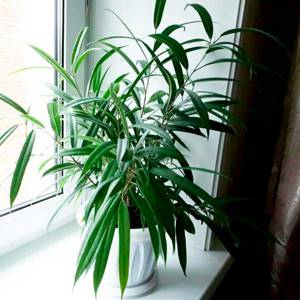
Correct lighting
Important! A lack of light can be signaled by a changed shape of the leaves: they become oblong, and the crown also thins out.
Watering
In summer, you need to water as the top layer of soil dries 1.5-2 cm thick. Water should not be allowed to accumulate in the pan, this can lead to rotting of the root system. In winter, when the growth of ficus slows down, you need to water even less often, until the soil dries completely. Benedict Ali can withstand drought, but not excess moisture.
Humidity
As noted above, Ficus Ali does not tolerate waterlogging; the soil should dry out between waterings to a depth of 3-5 cm. In summer, the frequency of watering is 2-3 times a week, in winter - 1 time. The water should be settled; pour it in small portions in several approaches. After 30-40 minutes. After watering, you need to remove the excess from the pan.
Priming
Special soil for ficus can be purchased at a flower shop, and this option is the most reliable. If this is not possible, you should try to make it yourself. For this you will need:
- turf;
- fine sand;
- brick chips;
- peat.
You need to mix the ingredients in equal parts and pour them into the pot. You also need to make drainage holes in it.
Feeding
Feeding is carried out during the period of active growth: from April to August once every 2 weeks. You need to use mineral and organic fertilizers, diluting them in water.
Important! You can’t spray ficus; fertilize only through the soil. In winter, long-leaved ficus does not need fertilizers.
Trimming
With good care, Ficus Ali grows both tall and wide, taking on a slightly sloppy appearance. Pruning will help create a beautiful shape and also strengthen the tree. It can be carried out only in early spring; the apical buds should be removed. White juice will be released from the cut site, which needs to be blotted with a sponge until it disappears completely. Then you need to cover the “wound” with crushed charcoal (activated or charcoal).
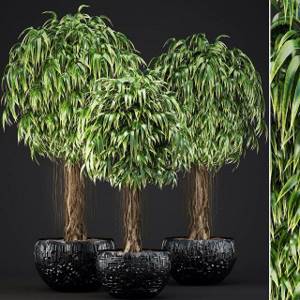
The result of a beautiful trim
If you plan to grow Ficus Benjamin Ali tall and spreading, you need to plant 2-3 shoots in a large pot. Their trunks can be intertwined with each other, creating a real living decoration for the room. The weave should not be too tight without preventing growth. Side shoots need to be pruned as they grow.
Important! The milky sap of the plant contains substances toxic to the skin. Due to the rubber content in it, ficuses are even considered poisonous.
All pruning work should be carried out only with gloves.
Is replanting required after purchase?
It is unknown how long the plant was in the store. In any case, small pots are used there. Therefore, it is recommended to replant it after purchase.
A healthy plant should change its container every 2-3 years. After purchase, you need to give the plant 7-12 days to acclimatize. When transplanting, it is removed from the pot along with the soil.
Important! In flower shops, plants are planted in temporary soil. But after purchasing a ficus, there is no need to use such soil in the future. It needs to be replanted carefully. However, it is not recommended to wash the roots.
You need to lay expanded clay on the bottom of the new container in a slide, which will serve as drainage, and pour the prepared soil on top. Next, the tree itself is placed in the pot, the root of which is covered with soil. It should be noted that you should not take the pot “for growth”. Its diameter should be 3-5 cm larger than the previous one.
Temporary soil can have a detrimental effect on the plant, and it begins to wither. This happens because the nutrients run out and are not suitable for normal growth over time.
When buying a healthy ficus, you need to pay attention to the following:
- no signs or fresh cuts on the trunk;
- all branches with foliage;
- the greens are bright, without signs of drying or spots;
- has no pests.
If there is a suspicion that the plant is sick, you should not buy it.
Possible problems in growing - diseases and pests
The main reason why ficus Natasha can get sick is improper care of the flower. It is necessary to constantly monitor the new plant, since very often the problem can only be determined by the method of elimination.
Causes of yellowing and falling of ficus leaves:
- excess moisture;
- poor soil;
- low temperature;
- insufficient lighting.
If planted incorrectly or the soil is of poor quality, problems with the root system may occur. This will be noticeable by the darkened leaves. If the temperature is too high or low, or if there is a lack of nitrogen, the leaves may curl into tubes.
Note! Sometimes the bush sheds its lower leaves. If in the fall this is a normal process, then at other times of the year the phenomenon may be associated with a sharp change in the indoor microclimate
In addition, Natasha can be attacked by aphids, thrips, spider mites and other pests. You can cope with them by regularly treating the bush with insecticides.
Superstitions and signs associated with the plant
There are several signs associated with the ficus being in the house.
- This plant is believed to cause gossip and scandals in the home. They also call him muzhegon.
- In other countries it is a symbol of family and harmony in the home.
In Thailand, he helps solve many complex problems. And in some Asian countries it is believed that ficus will help to conceive a child.
Thus, if you do not follow the basic rules of care, you can provoke yellowing and falling of the plant’s leaves. Ficus does not require special care. The main thing is that it is sufficiently humid and warm. By studying the features of ficus care, you can grow a large and healthy tree.
5 / 5 ( 1 voice )
Crown formation
Ficus tolerates pruning easily. With its help, the tree is given a certain shape. The classic version is a ball or standard in several tiers. Experienced gardeners practice bonsai skills and create complex figures.
Young plants are easier to shape and grow new shoots faster. Pruning is carried out in late spring - early summer. Unscheduled pruning is allowed at other times of the year if the plant has grown greatly and lost its shape. When pruning, it is recommended to adhere to the following rules:
- Too many branches are not cut at one time. It is recommended to do this gradually, focusing on the appearance and condition of the plant.
- Before trimming, the instrument is sharpened and sterilized.
- The cut is made at an angle. Branches pointing upward are trimmed.
- They try not to tear off excess leaves or damage the bark.
To increase the decorative effect of the trunks, they are intertwined and secured with thread. As it grows, new turns are added.
Advice! In summer, ficus can be taken out onto the balcony. Fresh air and plenty of sunlight will have a beneficial effect on his condition.
Trimming
Ficus pumila flower - description and care at home
Ficus Natasha requires only formative pruning. It is used to:
- form a standard tree;
- stimulate the growth of new shoots;
- give the bush a decorative look.
Pruning a flower The procedure is performed in the spring, since at this time new shoots form on the trunk, and pruning provokes their growth.
Important! It is not recommended to carry out replanting and pruning at the same time - this can have a negative effect on the flower.
Description and types
At home, ficus benjamina does not grow tall
A tree with a spreading crown reaches up to 20 m in height in nature. The optimal conditions for growth are considered to be the climate of India, Australia and the Philippines. The plant can be found in forests or at the foot of mountains. At home, a ficus can grow by about 1 m in 10 years.
The flower has a gray bark with dark inclusions. The crown is spreading with smooth green leaves. Ripe fruits are burgundy in color. They are inedible and serve a decorative function. A strong root system grows across the surface and deep into the soil. Mature trees have roots that extend beyond the soil.
The plant is sensitive to changing conditions. Therefore, it is necessary to provide proper care for the Benjamin ficus so that there are no problems with growth and development.
Ficus Benjamina Anastasia
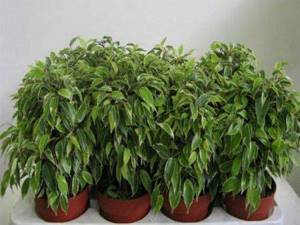
Popular varieties:
- Anastasia is a bush with a two-color crown. The leaves have an unusual wavy shape. Another distinctive feature is the bright vein in the middle.
- Twilight has an unusual color with white splashes. Thanks to this, the feeling of snow on the leaves is created. The variety is not demanding to care for.
- Baroque is characterized by curling foliage. The light green crown is no different in splendor. To give it a beautiful look, you need to plant several shrubs.
- Natasha is a decorative variety. A small tree with elongated leaves is suitable for creating a bonsai. Young shoots can be distinguished by their light color.
- Daniel is large in size. Ficus is capable of growing 30-40 cm in height per season. The leaves are ideally shaped with a smooth surface. Suitable for growing at home.
Ficus Natasha: description and features
Dwarf Natasha, whose height reaches 40-60 cm, is an excellent option for those who do not like huge indoor plants in tubs. Its advantage is the ability to create bonsai. Consequently, ficus will look great in a room of strict modern styles, classical and national. In any of them, an indoor flower will become a real decoration!
The homeland of ficus is the islands of Borneo, Java, and Ceylon. Here there are specimens reaching 10 meters in height, the trunk diameter of which is 1-1.2 m. But the “domesticated” version is adored by flower growers for the rich color of the foliage, ease of care and positive energy.
Ficus Natasha does not like changing places
Ficus Benjamin Natasha is different from others:
- bush height;
- the ability to twist the flexible trunks of several plants into one when creating a bonsai;
- small leaves, the size of which is 1.5x3 cm;
- shade of leaves. It can be not only uniformly green, but also have inclusions in the form of white dots and yellowish veins;
- easy formation, which allows you to get either a spreading mini-bush or a compact tree.
Ease of care and attractive appearance are factors that ensure Natasha’s enormous popularity. All that remains is to create optimal conditions for growth - and the whole family will fall in love with the flower.
Attention! When creating a bonsai, you can twist and tie young stems in a knot. However, it is worth remembering that those that have reached a height of 10-15 cm are most suitable for this.
Features of care
The plant is considered unpretentious, but may lose its decorative effect if not properly cared for.
- Lighting. Light-loving plant. Neutral to direct sunlight. In the shade, the leaves lose their gloss and the trunk becomes bent. The optimal location is southwest, southeast. The ficus is systematically rotated to uniformly shape the crown.
- Temperature. Loves warmth. Suitable temperature for growing is 25-30°C. In hot weather, spray daily.
- Humidity. Reacts gratefully to the creation of high humidity. In addition to spraying, the plant is bathed in a warm shower. In hot weather, water procedures are carried out more often. In winter, the batteries are covered with a wet cloth. The installation of special air humidifiers is encouraged.
- Watering. Watering is regular, moderate, using warm, settled water. The need for regular watering is determined by the degree of drying out of the soil. In summer only the top layer should dry out, in winter a little deeper. Complete drying is not allowed.
- The soil. Use special soils for ficuses. The mixture is prepared independently from turf, sand, bottom peat, and leaf soil. A small amount of perlite is added to loosen, and soaked hydrogel granules are added to maintain moisture.
- Transfer. Replant in the spring as the root system grows. Young trees - annually, older specimens - once every 2 years. The pot is filled one third with a drainage mixture - coarse sand, pebbles, fine expanded clay.
- Feeding. Fertilizers are applied in moderation in spring and summer. Use mineral complexes for ficuses. It is allowed to apply organic fertilizers in low concentrations.
Advice! Ficus responds gratefully to frequent spraying. It is recommended to do them twice a day. The crown of the plant is shaken from time to time. This promotes uniform distribution of air throughout the entire volume of the crown, making it lush.
Transfer
Replanting can only be done 3 weeks after purchasing the plant. Adult specimens are replanted once every 2-3 years.
- the width and height of the pot should only be 2-3 cm greater than the volume of the previous container, otherwise the plant may stop developing;
- it is necessary to arrange drainage at the bottom of the container;
- after removing the plant from the old soil, you need to shake off the old soil as much as possible and replant it in new nutritious soil;
- When planting, the root system is straightened, the pot is filled to the top with soil and watered.
Further care consists of timely watering, fertilizing, and pruning.
Listen to the advice of an amateur gardener:

